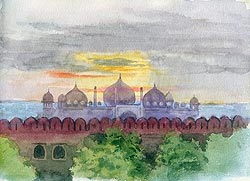The East India Company
 |
| Private, Grenadier Company, 2nd or Queen's. c 1839 (Khelat) (Click to enlarge) |

The posting to India had come as part of the routine deployment of regiments to support the British Governor-General at Calcutta in a country which for many seemed to have become the land of the English East India Company. There had been eight such companies. They came into being during the 17th century for the exploitation of trade in India, the East Indies and the Far East, but the English Company was the only one still in existence. The others had been those of Austria, Holland, France, Denmark, Scotland, Spain and Sweden. Portuguese seamen had shown the way many years earlier. They had taken advantage of developments in ship design and navigation aids to explore southwards to open up trade with the East at a time when the Ottoman Turks were dominating the land approaches to Europe. In 1488 they rounded southern Africa and began to develop trading posts northward on its eastern coast. Across the Atlantic Ferdinand Magellan found his way through the straits named after him to the Pacific Ocean. They reached Japan. They established a base at Goa on the west coast of India and in 1557 they created one at Macao in China.
The English Company was established in 1600 by a charter granted by Queen Elizabeth I to a number of London-based merchants who had traded individually but sought greater strength by doing so on a corporate basis. The charter gave them the exclusive privilege of trading beyond the Straits of Magellan and the Cape of Good Hope provided the trade was beneficial to the Crown. The Company’s first move was to open a shipyard at Deptford on the River Thames where it built the East Indiamen, the largest and best merchant ships of their time, well armed against piracy and the armed merchantmen of rival companies. It tried initially to break into the immensely profitable spice trade with the Molucca Islands east of Borneo but was prevented from doing so by the Dutch who were already dominant in that area. It turned its main effort instead to India where in 1623 it obtained the authority of the Mogul Emperor Jehangir to trade throughout the land. It had been reported to him that English ships had recently defeated a marauding Portuguese fleet in the Arabian Sea and he decided to depend on the English to protect pilgrims to Mecca.
 |
| Private, Battalion
Company, 31st Regiment. c1846 (Sobraon) (Click to enlarge) |
 The Company also benefited from strong support from England. Oliver
Cromwell regarded it as a means of achieving superiority over
the Dutch at sea. Charles II gave it Bombay, which he had received
as part of his marriage dowry, and which enabled the company to
dispense with its reliance on the up-river port of Surat further
north on the west coast. King Charles also enlarged its charter
to include the right to acquire territory, exercise civil and
criminal jurisdiction, make treaties, command armies and issue
its own currency.
The Company also benefited from strong support from England. Oliver
Cromwell regarded it as a means of achieving superiority over
the Dutch at sea. Charles II gave it Bombay, which he had received
as part of his marriage dowry, and which enabled the company to
dispense with its reliance on the up-river port of Surat further
north on the west coast. King Charles also enlarged its charter
to include the right to acquire territory, exercise civil and
criminal jurisdiction, make treaties, command armies and issue
its own currency.
In India the Company was able to acquire land on which it built the fortified trading bases Fort St. George at Madras and Fort William cotton goods from the north and on the River Hoogly downstream from Calcutta. It traded mainly in Madras in the east, in pepper from the Malabar ports south of Goa, in indigo from Lahore and silks from Persia, and in silks, sugar and saltpetre from Bengal and it prospered. Conditions began to change after the death of the Emperor Aurangzeb in 1707. His successors were weak and the Moghul Empire began to disintegrate. Landowners and other persons of substance - rajahs, nawabs, peshwas, zaminders - began to administer justice and collect revenues while claiming to do so in the Emperor’s name. The Company conformed.
Meanwhile it was facing increasing competition from the French Compagne des Indes which was based at Pondicherry south of Madras. It had trading posts on the east and south west coasts, and at Chandernagore north of Calcutta, and shelter for its ships at Mauritius during the monsoon. Its governors were men with visions of a French empire in India, but in France priorities lay elsewhere, in Europe and across the Atlantic. When the Companies went to war in India the Compagne des Indes and its allies were defeated by the forces of the English Company commanded brilliantly by their former tally clerk who had become a captain in the commissary to the troops. He was twenty five year old Robert Clive. His two great victories were at Arcot, inland from Madras in 1751, and the battle of Plassey in Bengal in 1757, following which the French Governor, Joseph Dupleix, was recalled to France and the Compagne des Indes was dissolved. In Bengal the English Company became the revenue collecting authority of the richest state in India.
 |
| (Click to enlarge) |
Even in the most favourable conditions it took several months to exchange views between London and Calcutta. Decisions could be taken locally in India and be justified as essential to stabilize a frontier or an internal situation which could hardly be repudiated from London nearly a year later. Consequently Parliament approved a Regulating Act in 1773 whereby a Governor-General was appointed to represent the monarch and the British Government throughout India. He was installed in Calcutta and was paid for by the English Company. Ten years later the India Act of 1783 established a Board of Control through which Parliament gained a general power of supervision over the Company’s affairs, and set up the India Office in Whitehall. It also required the Company to provide well-paid administrators for its possessions, separate from its commercial interests. For its part the Company purchased Hailey Bury House in Hertfordshire and its surrounding estate where it created a college for the education and training of boys as potential administrators.
In 1813 Parliament withdrew the Company’s monopoly of trade with India. Nevertheless by the time the Queen’s and the 31st Foot arrived in 1825 it was dominant throughout much of the land. It had annexed several states. In many others it had installed its troops to guarantee the local ruler his throne. He met the cost, but they were under the control of a British Resident Commissioner. The Company had acquired much territory in the south following the Mysore Wars of 1780 and 1790. In the west the Maharatta chiefs had ultimately submitted after a succession of campaigns, the last one in 1817. In the east the Gurkhas of Nepal were finally defeated in 1816. In the north, however, across the River Sutlej, lay the Sikh empire with its formidable army trained by Napoleon’s veterans. Beyond the Sikhs were the Baluchi and Pathan tribal territories, Afghanistan and Persia, all potentially vulnerable to Russian occupation and further expansion into India, or at least so it was thought in London.
Related
